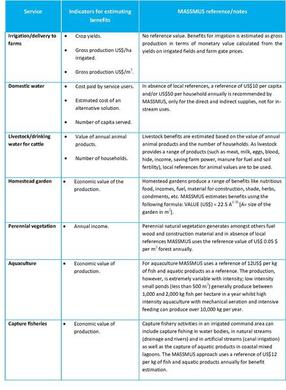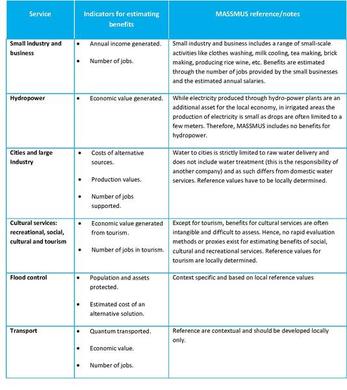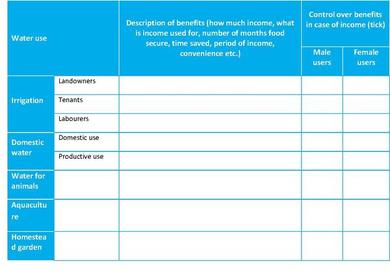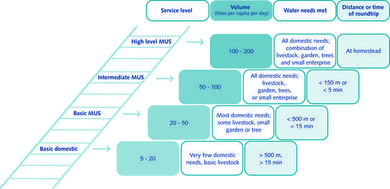Tool 17
TOOL 17. ESTIMATING THE BENEFITS OF SERVICES
To map the order of magnitude of the benefits of multiple use services and produce some useful recommendations for further refined investigations.
Estimating the benefits of multiple-use water services is important in order to raise awareness among key decision makers of the multiple (de facto) services provided by the water infrastructure. This is also important for improving management and governance of the system with a true service oriented approach; and for improving decision making in water allocation and cost sharing.
OBJECTIVE
To map the order of magnitude of the benefits of multiple use services and produce some useful recommendations for further refined investigations.
METHOD
The benefit of the multiple uses of water can be expressed and determined in many different ways, each of which provides useful information. The following table (Table 12) shows examples of value indicators that could be identified using a rapid appraisal approach.
Detailed economic valuation per use may be carried out following various methods. The following are different techniques for valuation that can be utilised for determining the economic values of the uses and functions of MUS:
- Productivity Method:Estimates economic values for services that contribute to the production of goods/services that are bought and sold in commercial markets for instance, irrigated agriculture.
- Hedonic Pricing Method:Estimates economic values for services that directly affect market prices of some other goods, for instance, the effect of water supply on real estate prices)
- Travel Cost Method:Estimates economic values for services associated with sites by assuming the value is reflected in willingness to pay to travel to visit the site.
- Contingent Valuation Method:Estimates economic values for services by asking people to directly state their willingness to pay based on hypothetical situations[1].
The data availability is very critical for the benefit evaluation and the accuracy with which the assessment can be made. Time constraints, pragmatism and data availability will dictate the methodology used to evaluate the benefits. As the key objective is to approximately identify the prominent benefits, references values can be used to characterise the benefit of each service. Some reference values for benefits can be found in Table 12.
Table 12 - MASSMUS indictors for benefit estimation of specific water uses and their related references


Source: Renault, et al., n.d.
These methods largely focus on economic values and subsequently do not show other benefits derived from the water-use services to which male and female users might attribute different levels of importance. For example, irrigation, homestead gardens, livestock, and aquaculture do not only have economic values, but also contribute to stable food supplies for the household and improved nutritional status of its members. This might be of key interest for female users, as they are primarily responsible for feeding the family. Furthermore, many water uses like home gardening, vegetable production, small livestock production, low intensity aquaculture and small industry and business activities like clothes washing, brewing, and patchwork, are usually women’s responsibilities. These activities do not only generate income for the household, but also contribute to women’s economic independence (Wiegers and Wahaj, forthcoming).
The following exercise can be done in a focus group or key informant interview in order to identify both direct and indirect benefits, and who has control over these benefits.
Step 1: Introduction
Introduce the exercise to the participants of a focus group discussion/key informants and draw a matrix on a flipchart. See example in Table 13.
Table 13 - Benefits of multiple water use services

Source: Renault, et al., n.d.
Step 2: List benefits
Ask the participants/key informants to list for each water-use service main benefits. Write these in the second column. Describe each benefit in terms whether for income or own consumption, amount of income, period of income, what is income used for, time saved, etc.).
Step 3: Control over benefits
Ask participants/key informants to identify, for each water-use service which gains income, who (male or female user) has control (makes decisions) over this income.
Step 4: Discussion
Based on the above, discuss what areas require further investigation and what are the reasons for this.
TIPS AND TRICKS
- A MUS project typically produces impacts in various benefit categories, such as income, production (crops, fish, livestock, hydropower, jobs, etc.), health or nutrition status. This means that there are multiple variables. In order to compare and sum them, there is need for common units, such as the monetary value per unit of input (for instance US$ benefit per US$ of input, or US$ per drop of water). It is not always easy or feasible to define such values, particularly where more process benefits are identified, such as increased community cohesion. Making benefits visible is often an important first step.
- Benefits can also be expressed at system level, for example in the form of a longer life-span of a service, or in the form of less break-downs. This in turn will affect the discount rate on the cost side as well.
- Benefits are closely linked to the service level provided. An analysis of benefits therefore needs to be linked to service levels. The water service ladder (Figure 3), where relevant, can be a useful tool in this.
Figure 3 - Water ladder

Source: Renwick, 2007; Van Koppen et al., 2009
BASED ON
Renault, D. et al., forthcoming. Multiple uses of water services in large irrigation systems, Auditing and planning modernisation. The MASSMUS Approach. FAO ID 66, Rome: Food and Agriculture Organization of the United Nations.
Tool 3 in: Wiegers, E., and Wahaj R., forthcoming. Multiple Uses of Water Services for Men and Women in Large Irrigation Systems: Engendering the MASSMUS approach, MASSMUS Gender Module, Rome: Food and Agriculture Organization of the United Nations.
Smits, S. 2010. Cost-benefit analysis of multiple-use services (MUS), Report of expert meeting and workshop. The Hague: IRC International Water and Sanitation Centre.
Based on MASSMUS, Annex 2, based on a brief written by Sabina Pendse MSc from Yale University USA (Volunteer at FAO NRL in 2009).
